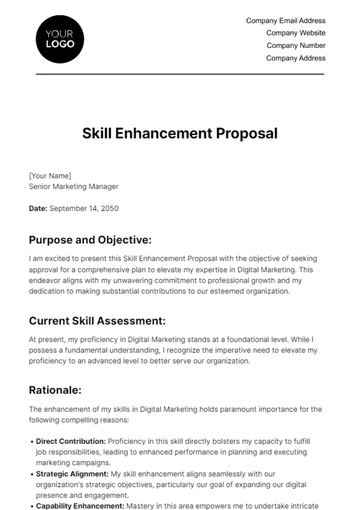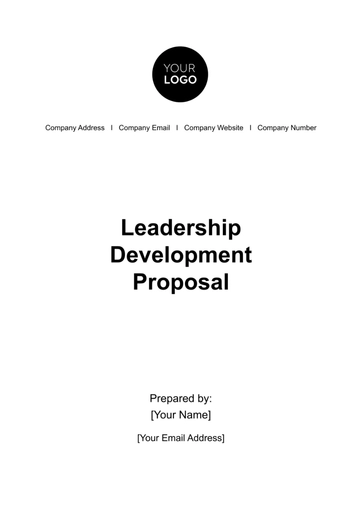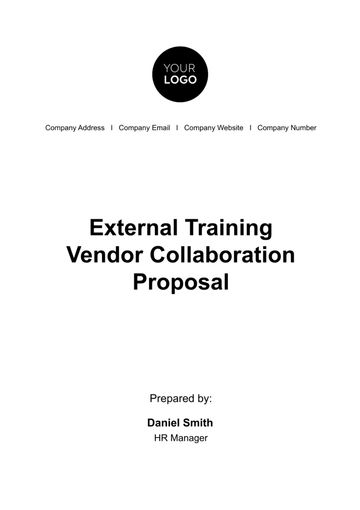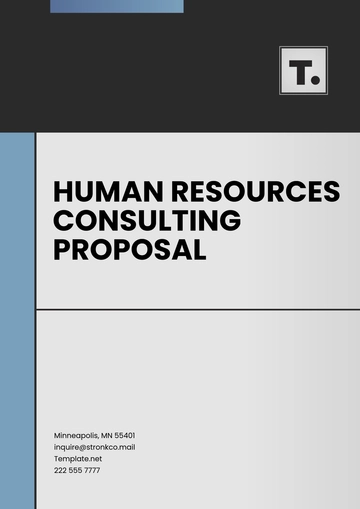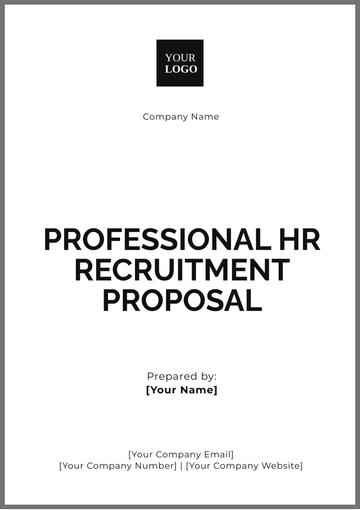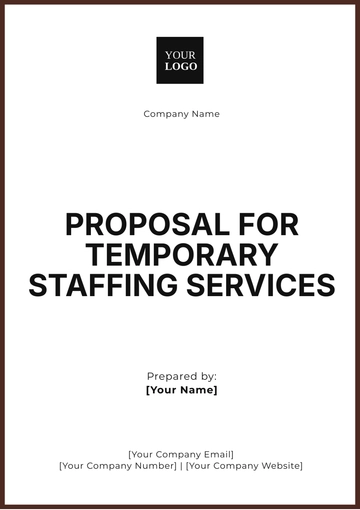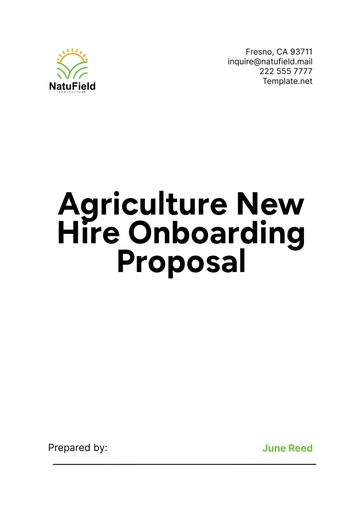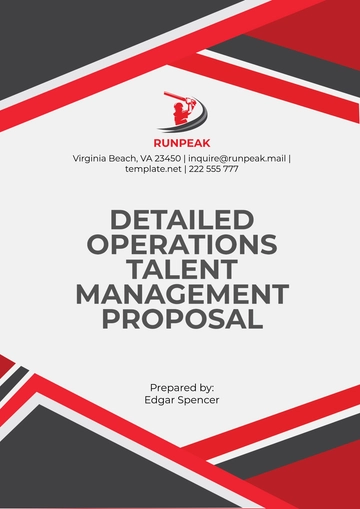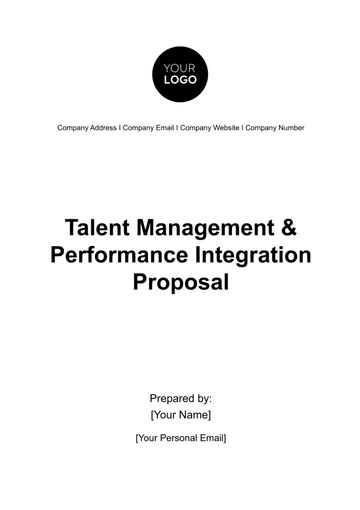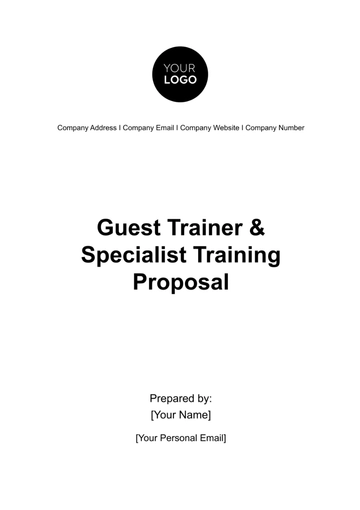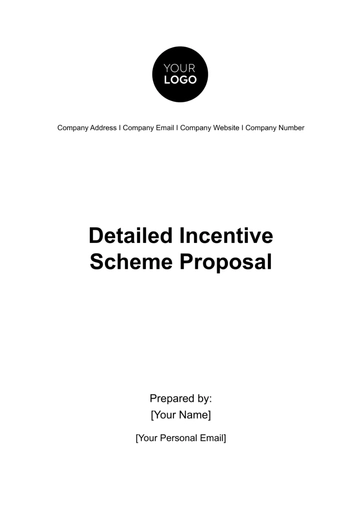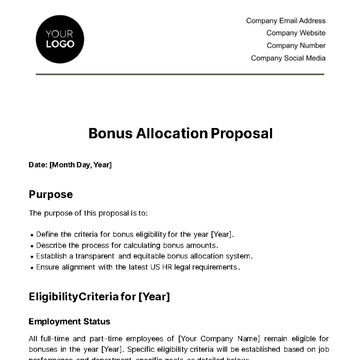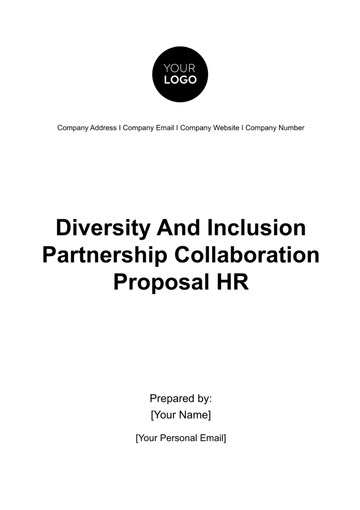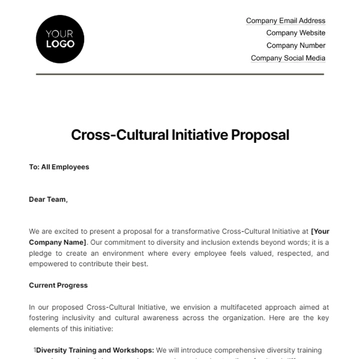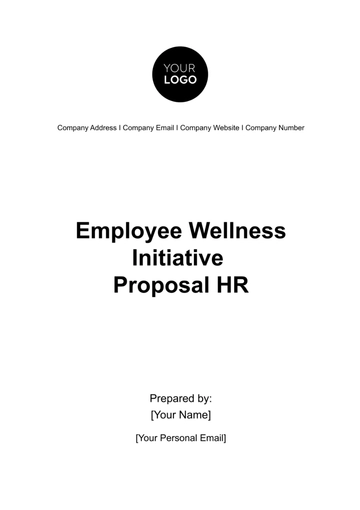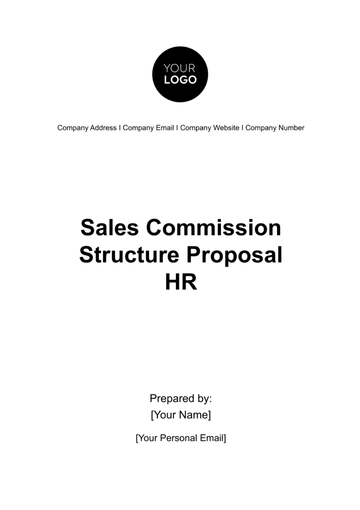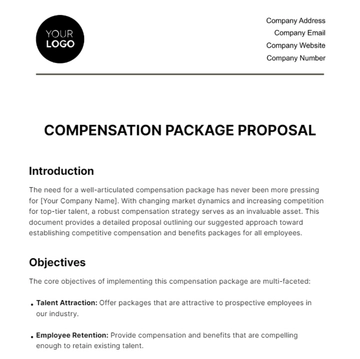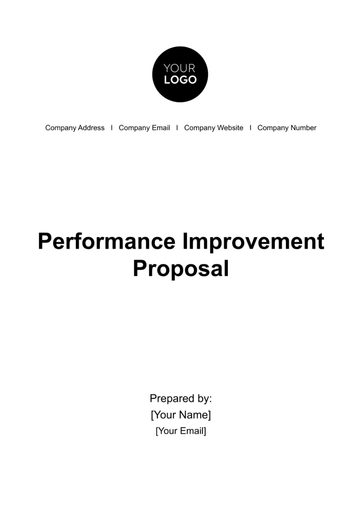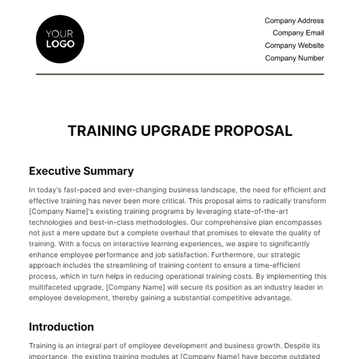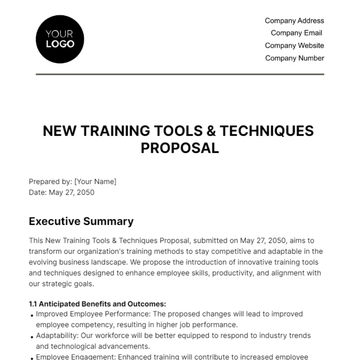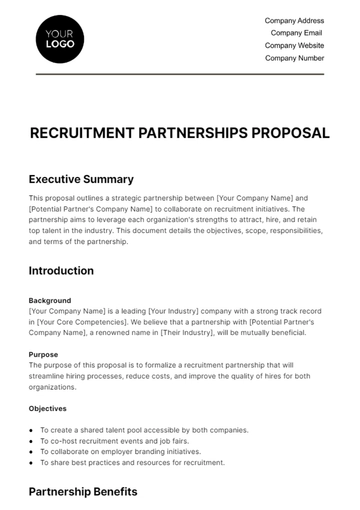Free Agriculture New Hire Onboarding Proposal
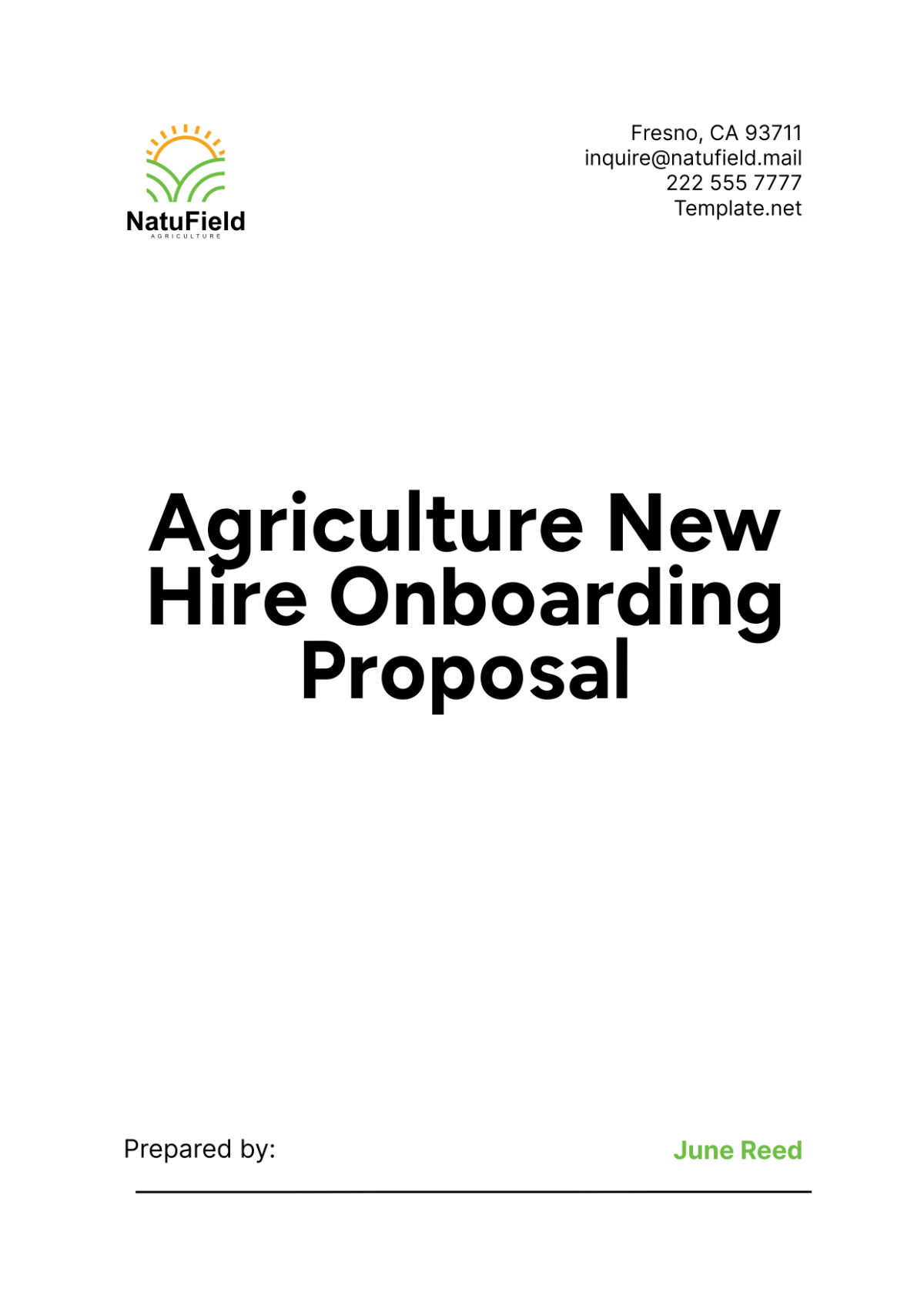
Introduction
Effective onboarding is crucial for integrating new hires into [Your Company Name] and ensuring they become productive members of the team quickly and smoothly. This proposal outlines a comprehensive onboarding program designed to introduce new employees to our agricultural operations, culture, and values, providing them with the tools and knowledge needed for success.
1. Objectives
The primary objectives of the onboarding program at [Your Company Name] are designed to ensure a smooth transition for new hires into the company's operational and cultural environment. By focusing on integration, training, engagement, and compliance, we aim to create a foundation for long-term success and satisfaction for all new employees.
1.1 Integrate New Hires into the Company Culture and Operational Framework
Seamless Integration: The first objective is to integrate new hires seamlessly into the company culture and operational framework. This means familiarizing them with the company’s mission, vision, and core values, as well as the day-to-day operations. Understanding the company's culture is crucial for new employees to feel part of the team and align their personal goals with the company’s objectives.
Cultural Familiarity: Through orientation sessions, team-building activities, and mentorship programs, new hires will be introduced to the company’s cultural norms and values. This helps them understand how their role fits into the larger picture and fosters a sense of belonging and purpose.
Operational Understanding: Additionally, providing a thorough overview of the company’s operational processes ensures that new employees understand how different departments function and how their specific roles contribute to overall productivity. This includes familiarizing them with standard operating procedures (SOPs), workflows, and internal communication channels.
1.2 Provide Necessary Information, Training, and Resources
Comprehensive Information: New hires need comprehensive information to perform their jobs effectively. This includes detailed job descriptions, expectations, and performance metrics. Providing access to a well-structured employee handbook that outlines company policies, benefits, and procedures is essential.
Role-Specific Training: Tailored training programs are crucial to equip new employees with the skills and knowledge required for their specific roles. This involves technical training for job-specific tasks, safety training to comply with industry standards, and soft skills training to enhance communication and teamwork.
Resource Allocation: Ensuring that new hires have access to the necessary resources is equally important. This includes setting up their workstations with the required tools, software, and access to relevant databases. Providing them with the right resources from the start enables them to hit the ground running and reduces the time it takes to reach full productivity.
1.3 Enhance Employee Engagement and Retention
Positive Initial Experience: Creating a positive initial experience is a critical objective of the onboarding program. First impressions matter, and a well-organized onboarding process can significantly impact new employees' perceptions of the company. By making new hires feel welcomed and valued from day one, we set the stage for long-term engagement.
Building Connections: Engagement is fostered by building connections within the company. Introducing new employees to their colleagues and encouraging participation in team activities helps build rapport and a sense of community. Regular check-ins with supervisors and mentors provide support and guidance, ensuring that new hires do not feel isolated.
Retention Strategies: High employee engagement leads to better retention rates. An effective onboarding program reduces turnover by ensuring that new hires feel confident in their roles and connected to the company. By addressing potential challenges early on and providing ongoing support, we can improve job satisfaction and reduce the likelihood of early departures.
1.4 Ensure Compliance with Legal and Safety Regulations
Legal Compliance: Compliance with legal and safety regulations is a fundamental objective of the onboarding program. New hires must be aware of and adhere to all relevant labor laws, company policies, and industry standards. This includes understanding their rights and responsibilities as employees and the company’s obligations as an employer.
Safety Training: Safety training is a critical component of legal compliance. New employees must be trained on workplace safety protocols, emergency procedures, and the proper use of personal protective equipment (PPE). Ensuring that all employees are knowledgeable about safety regulations helps prevent accidents and injuries, creating a safer work environment for everyone.
Documentation and Record-Keeping: Proper documentation and record-keeping are essential for compliance. This includes maintaining accurate records of training sessions, signed acknowledgment forms for company policies, and any other necessary legal documents. Ensuring that all paperwork is completed correctly and stored securely protects the company from potential legal issues and demonstrates a commitment to regulatory compliance.
1.5 Additional Considerations
Continuous Improvement: The onboarding program should be continuously evaluated and improved based on feedback from new hires and supervisors. Regularly updating training materials, refining processes, and incorporating new technologies can enhance the effectiveness of the onboarding experience.
Feedback Mechanisms: Implementing feedback mechanisms allows new hires to share their experiences and suggestions for improvement. This feedback is invaluable for identifying areas where the onboarding process can be refined and ensures that the program remains responsive to the needs of new employees.
Adaptability: Finally, the onboarding program should be adaptable to accommodate different roles, levels of experience, and individual learning styles. A flexible approach ensures that all new hires, whether entry-level or experienced professionals, receive the support they need to succeed in their roles.
2. Onboarding Program Overview
The onboarding program at [Your Company Name] is structured into four main phases: Pre-boarding, Orientation, Initial Training, and Ongoing Support.
2.1 Pre-Boarding
Pre-boarding begins as soon as the candidate accepts the job offer. This phase is crucial for setting the tone and ensuring that the new hire feels welcomed and prepared for their first day.
Activities:
Sending a welcome email with details about the first day, including start time, dress code, and what to bring.
Providing access to an online portal with information about the company, team, and role-specific resources.
Completing necessary paperwork, such as tax forms, direct deposit information, and confidentiality agreements.
Setting up the new hire's workstation, including computer, email, and phone setup.
2.2 Orientation
Orientation takes place on the first day and aims to provide new hires with a comprehensive understanding of the company's operations, culture, and expectations.
Activities:
A formal welcome session conducted by the HR manager, introducing the company’s history, mission, vision, and core values.
Facility tour, including work areas, break rooms, restrooms, and emergency exits.
Introduction to team members, supervisors, and key personnel.
Distribution and explanation of the employee handbook, covering company policies, code of conduct, benefits, and compensation.
Health and safety training, including emergency procedures and safety protocols relevant to their roles.
2.3 Initial Training
Initial Training is tailored to the specific role of each new hire, providing both theoretical knowledge and practical skills essential for job performance.
Activities:
Job-specific training, including standard operating procedures (SOPs) and equipment use.
Technical skills training for machinery operation and maintenance.
Soft skills training covering communication, teamwork, and time management.
Assigning a mentor or buddy to assist with the transition and provide guidance.
2.4 Ongoing Support
Ongoing Support ensures that new hires continue to receive the necessary support and resources to succeed in their roles and integrate fully into the company.
Activities:
Regular check-ins with supervisors to discuss progress, answer questions, and provide feedback.
Scheduled performance evaluations at the end of the probationary period and semi-annually.
Continuous training opportunities, including workshops, seminars, and online courses.
Participation in team-building activities and social events to foster a sense of community.
3. Detailed Onboarding Plan
3.1 Pre-Boarding Plan
Objective: Ensure new hires feel welcomed and prepared for their first day.
Tasks:
Welcome Email: Send a personalized welcome email outlining the first day’s schedule, dress code, and what to bring.
Online Portal Access: Provide access to an online portal with information about the company, the team, and role-specific resources.
Paperwork Completion: Ensure all necessary paperwork is completed, including tax forms, direct deposit information, and confidentiality agreements.
Workstation Setup: Prepare the new hire’s workstation, including computer, email, phone setup, and necessary office supplies.
3.2 Orientation Plan
Objective: Introduce new hires to the company’s operations, culture, and expectations.
Tasks:
Welcome Session: Conduct a formal welcome session with the HR manager, introducing the company’s history, mission, vision, and core values.
Facility Tour: Provide a tour of the company’s facilities, including work areas, break rooms, restrooms, and emergency exits.
Team Introductions: Introduce new hires to their team members, supervisors, and key personnel.
Employee Handbook: Distribute and explain the employee handbook, covering company policies, code of conduct, benefits, and compensation.
Health and Safety Training: Conduct health and safety training, including emergency procedures and safety protocols relevant to their roles.
Table: Orientation Schedule
Time | Activity | Responsible Person |
|---|---|---|
9:00 AM - 9:30 AM | Welcome Session | HR Manager |
9:30 AM - 10:00 AM | Facility Tour | Supervisor |
10:00 AM - 10:30 AM | Team Introductions | Team Leader |
10:30 AM - 11:00 AM | Employee Handbook Overview | HR Manager |
11:00 AM - 12:00 PM | Health and Safety Training | Safety Officer |
3.3 Initial Training Plan
Objective: Equip new hires with the knowledge and skills necessary to perform their jobs effectively.
Tasks:
Job-Specific Training: Provide training on specific tasks, machinery, and tools that the new hire will use.
Technical Skills Training: Conduct training sessions on machinery operation, maintenance, and other technical skills relevant to the role.
Soft Skills Training: Provide training on communication, teamwork, and time management.
Mentorship Program: Assign a mentor or buddy to assist the new hire with the transition and provide ongoing guidance.
Table: Training Schedule
Day | Activity | Trainer |
|---|---|---|
Day 1 | Job-Specific Training | Supervisor |
Day 2 | Technical Skills Training | Technical Trainer |
Day 3 | Soft Skills Training | HR Trainer |
Day 4 | Mentorship Program Introduction | Assigned Mentor |
3.4 Ongoing Support Plan
Objective: Provide continuous support to ensure the new hire’s success and integration into the company.
Tasks:
Regular Check-Ins: Schedule regular check-ins with supervisors to discuss progress, answer questions, and provide feedback.
Performance Evaluations: Conduct performance evaluations at the end of the probationary period and semi-annually to assess the new hire’s performance and identify areas for improvement.
Continuous Training Opportunities: Offer workshops, seminars, and online courses to provide ongoing training and development.
Team-Building Activities: Organize team-building activities and social events to foster a sense of community and belonging.
Table: Ongoing Support Schedule
Timeframe | Activity | Responsible Person |
|---|---|---|
Weekly | Regular Check-Ins | Supervisor |
End of 3 Months | Probationary Period Performance Evaluation | HR Manager |
Every 6 Months | Semi-Annual Performance Evaluation | Supervisor |
Quarterly | Continuous Training Opportunities | Training Coordinator |
Quarterly | Team-Building Activities | HR Coordinator |
4. Resource Allocation
4.1 Budget
The successful implementation of the onboarding program requires adequate resources. The budget allocation includes costs for training materials, technology, staff time, and team-building activities.
Table: Budget Allocation
Item | Estimated Cost |
|---|---|
Training Materials | $5,000 |
Technology (e.g., Software) | $3,000 |
Staff Time (Trainers, HR) | $10,000 |
Team-Building Activities | $2,000 |
Miscellaneous | $1,000 |
Total | $21,000 |
4.2 Personnel
Dedicated personnel are required to effectively carry out the onboarding process. This includes HR staff, trainers, mentors, and supervisors.
Key Personnel:
HR Manager: Oversees the entire onboarding program and ensures all procedures are followed.
Supervisors: Provide job-specific training and regular check-ins.
Trainers: Conduct technical and soft skills training.
Mentors: Offer guidance and support to new hires.
5. Evaluation and Improvement
5.1 Evaluation Metrics
The effectiveness of the onboarding program will be evaluated using specific metrics to ensure continuous improvement.
Metrics:
New Hire Retention Rate: Percentage of new hires who remain with the company after one year.
Time to Productivity: The average time it takes for new hires to reach full productivity.
Employee Satisfaction: Feedback from new hires on their onboarding experience through surveys and interviews.
5.2 Continuous Improvement
Based on the evaluation metrics, the onboarding program will be continuously reviewed and improved to ensure it meets the evolving needs of the company and its employees.
Improvement Strategies:
Feedback Implementation: Regularly collect and implement feedback from new hires and supervisors to enhance the onboarding process.
Best Practices: Stay updated on industry best practices and incorporate them into the program.
Technology Integration: Utilize new technologies to streamline and improve onboarding activities.
Conclusion
A comprehensive and effective onboarding program is essential for integrating new hires into [Your Company Name] and ensuring their long-term success and satisfaction. By following the structured approach outlined in this proposal, we can provide new employees with a positive and supportive introduction to the company, enhancing their productivity and engagement.
This proposal outlines a robust plan for onboarding that includes pre-boarding, orientation, initial training, and ongoing support. By allocating appropriate resources and continuously evaluating and improving the program, [Your Company Name] can achieve its goals of high employee retention, increased productivity, and a positive company culture.
Prepared by:
[Your Name]
[Your Title]
[Your Company Name]
[Your Company Number]
- 100% Customizable, free editor
- Access 1 Million+ Templates, photo’s & graphics
- Download or share as a template
- Click and replace photos, graphics, text, backgrounds
- Resize, crop, AI write & more
- Access advanced editor
Welcome new team members effectively with Template.net's Agriculture New Hire Onboarding Proposal Template. This editable and customizable template, enhanced with our AI editor tool, provides a structured approach to integrating new hires into your agricultural business. Ensure a smooth transition and effective training with this comprehensive guide, ideal for establishing a robust onboarding process.
You may also like
- Business Proposal
- Research Proposal
- Proposal Request
- Project Proposal
- Grant Proposal
- Photography Proposal
- Job Proposal
- Budget Proposal
- Marketing Proposal
- Branding Proposal
- Advertising Proposal
- Sales Proposal
- Startup Proposal
- Event Proposal
- Creative Proposal
- Restaurant Proposal
- Blank Proposal
- One Page Proposal
- Proposal Report
- IT Proposal
- Non Profit Proposal
- Training Proposal
- Construction Proposal
- School Proposal
- Cleaning Proposal
- Contract Proposal
- HR Proposal
- Travel Agency Proposal
- Small Business Proposal
- Investment Proposal
- Bid Proposal
- Retail Business Proposal
- Sponsorship Proposal
- Academic Proposal
- Partnership Proposal
- Work Proposal
- Agency Proposal
- University Proposal
- Accounting Proposal
- Real Estate Proposal
- Hotel Proposal
- Product Proposal
- Advertising Agency Proposal
- Development Proposal
- Loan Proposal
- Website Proposal
- Nursing Home Proposal
- Financial Proposal
- Salon Proposal
- Freelancer Proposal
- Funding Proposal
- Work from Home Proposal
- Company Proposal
- Consulting Proposal
- Educational Proposal
- Construction Bid Proposal
- Interior Design Proposal
- New Product Proposal
- Sports Proposal
- Corporate Proposal
- Food Proposal
- Property Proposal
- Maintenance Proposal
- Purchase Proposal
- Rental Proposal
- Recruitment Proposal
- Social Media Proposal
- Travel Proposal
- Trip Proposal
- Software Proposal
- Conference Proposal
- Graphic Design Proposal
- Law Firm Proposal
- Medical Proposal
- Music Proposal
- Pricing Proposal
- SEO Proposal
- Strategy Proposal
- Technical Proposal
- Coaching Proposal
- Ecommerce Proposal
- Fundraising Proposal
- Landscaping Proposal
- Charity Proposal
- Contractor Proposal
- Exhibition Proposal
- Art Proposal
- Mobile Proposal
- Equipment Proposal
- Student Proposal
- Engineering Proposal
- Business Proposal
